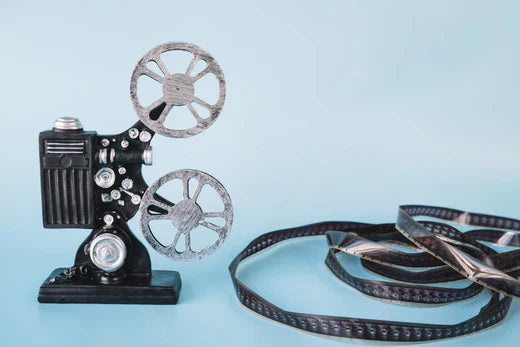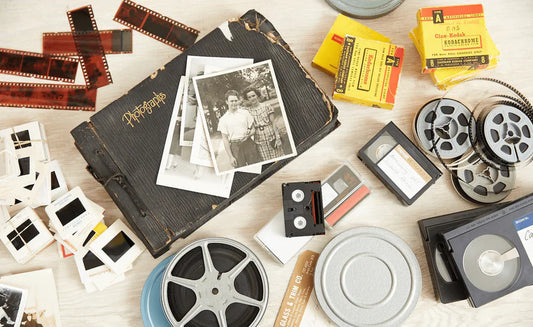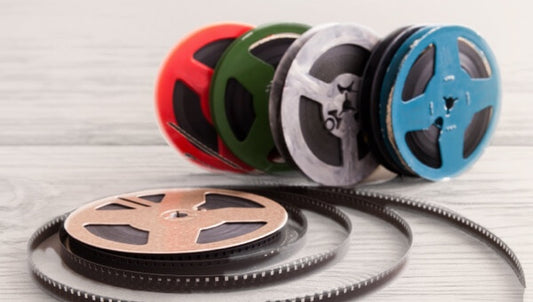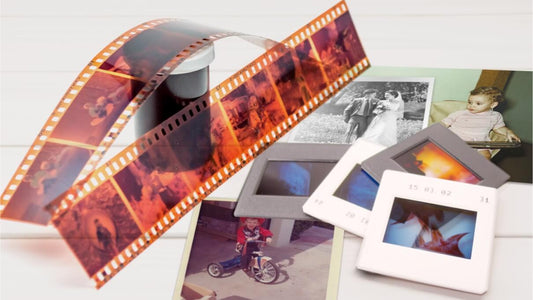In 2025, we can stream endless movies, shows, and even digitized home videos instantly. But before digital technology, film reels were the gold standard, and for a long time, the only way to store motion pictures in a compact format ready for projection. That simple question, “What is a film reel?”, has a fascinating answer that blends history, technology, and preservation. Keep reading to explore the history of film reels, the different types, what they’re made of, how they work, and the best ways to store and preserve them for the future.
Jump To:
- What Is a Film Reel?
- History of Film Reels
- Types of Film Reels
- Components of a Film Reel: How are film reels played?
- Analog vs. Digital Film Reels
- How Film Reels are Made
- Storing and Preserving Film Reels
- Film Reels in the Digital Age
What Is a Film Reel?
A film reel is a circular spool used to hold, wind, and project motion-picture film. Made of metal or plastic, it keeps long strips of film organized and allows them to be fed smoothly through a projector. Each reel typically contains a fixed length of film, which could range from a few minutes of home video to an entire section of a feature film.
Film reels served two purposes: they provided a compact way to store film safely and made it possible to project moving images for audiences. From Hollywood blockbusters to family home movies, reels were the standard way to record and share motion pictures for nearly a century. Film reels were used for formats like 8mm, and Super 8 film, which became especially popular for home movies.

Before digital streaming, film reels were the standard way to store and project movies.
History of Film Reels
Film reels have long been iconic in motion pictures, circular spools that resemble a wheel and became a lasting symbol of Hollywood. While the term film reel can also mean a demo reel or showreel, here we’re focusing on the physical reels used to store and project movies.
When were film reels invented?
Not long after the first video was recorded, Thomas Edison introduced one of the earliest motion picture cameras in 1892. It used two reels, an early setup that later inspired reel-to-reel projectors. These cameras captured images on strips of plastic film coated with gelatin emulsion and silver halide crystals—the process that brought motion pictures to life.
Rise of Cinema (1900s)
By the early 1900s, virtually all moving images, feature films, newsreels, and even early television, were recorded on reels. This innovation made film easier to store and allowed projection to packed theaters, laying the foundation for the modern movie industry.
Expansion into Home Formats (1920s–1960s)
- 1923 – 16mm film introduced by Eastman Kodak, making home projection more practical.
- 1930s – 8mm film provided an even more accessible option for amateurs, though initially silent.
- 1965 – Super 8 film improved both picture quality and sound recording, allowing families to capture home movies with audio.
Transition to Magnetic Tape and Digital (1970s–2000s)
For decades, reels remained the dominant medium. That changed with the invention of VHS tapes in the late 1970s, which used magnetic tape instead of film. By the 1990s, the rise of the first digital cameras signaled the true end of the film reel era, shifting the industry toward digital recording and projection.
Types of Film Reels
The history of film reels is extensive but understanding them starts with film reel sizes. Early film spools were designed to hold about 1,000 feet of 35mm film, giving a runtime of roughly 10 minutes.
Because of this limitation, films originally required multiple reels. As technology advanced, larger reel sizes were developed so that an entire movie could fit onto a single reel instead of being shown across two, three, or more reels.
16mm Reels
- Typically hold 50 to 800 feet of film.
- Usually did not include audio.
- Feature sprockets on only one side, unlike the dual-sprocket design of silent 35mm film.
8mm Reels
- Provide about twice the playback duration of a 16mm reel of the same size.
- Became popular for amateur and family recordings.
Super 8 Reels
- Same physical reel size as 8mm but offered improved picture quality.
- More likely to include sound, often identified by a rust-colored strip along the film edge.
In short, every type of film had its own type of reel, but reels can also be categorized simply by diameter size, which determined how much footage they could store. Collectors today often wonder how to view 16mm film without a projector, since these reels were once designed exclusively for projection equipment.

Film reels came in formats like 16mm, 8mm, and Super 8 for home and theater use.
Components of a Film Reel: How are film reels played?
Film rolls consist of the emulsion and base that make up the film itself. Old video cameras for film would expose the silver halide crystals inside the emulsion to light, which darkened the surface and formed an invisible image. This image was later developed with chemical baths, producing the photographic picture.
This process is almost the same as the one used for photographs, photo slides, and other forms of analog photography. The difference with motion picture film is that the perforations along the edges attach the film to a reel so it can play as a moving image on a projector.
During the silent era, a projectionist had to move quickly from one standard-length reel to another to keep a movie running. The sprockets held the spool of film on the projector, and as it spun, the reel unwound and displayed the images in front of the projector lamp.
Finally, there are the hubs and flanges that make up the remaining parts of the reel. The hubs provide the circular shape needed for smooth spinning during projection, while the flanges protect and stabilize the film. Together, these components allowed the reel to function reliably and to preserve its quality for years, so long as the film itself wasn’t already brittle, damaged, or worn out.
| Film Reel Width | Film Length | Approximate 8mm and Super 8 Running Time | Approximate 16mm Running Time |
|---|---|---|---|
| 3 inches | 50 feet | 3 minutes | 1 minute |
| 4 inches | 100 feet | 6 minutes | 2 minutes |
| 5 inches | 200 feet | 12 minutes | 6 minutes |
| 6 inches | 300 feet | 15 minutes | 8 minutes |
| 7 inches | 400 feet | 24-25 minutes | 12 minutes |
| 10.5 inches | 800 feet | 45-55 minutes | 25-30 minutes |
| 12 inches | 1200 feet | N/A | 40-45 minutes |
| 14 inches | 1600 feet | N/A | 45-55 minutes |
| 16 inches | 2000 feet | N/A | 60-74 minutes |
Analog vs. Digital Film Reels
The significance of film reels in cinema cannot be overstated, but the era of film reels has long been gone. Today, digital films no longer require reels, and most movie theaters around the world have transitioned away from them entirely.
Digital projectors are now the standard. They’re more compact, affordable, and easier to edit than analog film. With digital, studios can quickly add overdubbing or subtitles in multiple languages, including English, Spanish, Japanese, and French, without the need for new physical copies.
This shift isn’t limited to theaters. Around the world, families have been digitizing home movies, replacing analog footage with digital formats for easier storage and playback. In Hollywood, distributors now deliver new releases as Digital Cinema Packages (DCPs) - plastic cases containing a hard drive with the movie files. Each DCP requires a licensed activation code before a projectionist can play it for audiences.
Still, some filmmakers continue to work with them. This might be because it’s just what they are used to from learning it before the digital age, but others like the ability to add practical effects due to the way film reels work. Finally, nostalgia can be a powerful incentive to stick to old film reel formats.
How Film Reels are Made
The most complex part of how film reels are made is understanding how film itself works. As mentioned earlier, film tape is built in layers that react to light. Inside the emulsion, silver halide crystals suspended in gelatin change when exposed to light, producing contrasting colors that form the image.
Sound is recorded on old film formats by using a variable-area soundtrack process, or SVA. This allows sound to be recorded on a transparent line along the movie film. If you don’t know how a projector works, it basically shines light through the images on the film reel.
The film reel will basically move at a certain speed to display the projected image onto a screen at the right speed. When the light passes through the film on a photodetector, it changes the light to an electrical current and sends this to a pre-amplifier which produces the sound.
To create both the visual and audio elements, the film undergoes light exposure and chemical development - similar to how a disposable camera is processed. Once developed, the strips of motion picture film are wound and attached to reels, completing the manufacturing process.

Store reels in cool, dry places and digitize them to preserve memories.
Storing and Preserving Film Reels
To ensure film reels last as long as possible, they should be stored in a cool, dark, and dry place. Depending on storage conditions, film can last as little as 2 years or more than 25 years. Proper storage helps protect against fading from light, warping from humidity, or damage to the film layers and spools.
Another important step is preserving analog film as digital copies. For example, if you have old Super 8 camera footage, digitizing it will protect those memories from being lost. You don’t have to throw away the original reels, but creating a digital version guarantees that your films remain safe and accessible for the future.
You can digitize Super 8 film and other reel types yourself, or work with one of the best companies that digitize home movies to handle the process professionally. Either way, digitization ensures that your footage lives on as digital heirlooms, something to pass down to parents, grandparents, children, and future generations.
Film Reels in the Digital Age
If you’ve ever wondered, “What is a film reel?” now you know that film reels are basically just photography kept on a spool to display on a projector at a certain speed to mimic motion. While this format has largely been replaced by digital videos, it greatly influenced the Hollywood industry and old film reels still exist in people’s collections and archives.
However, film can only last forever if you digitize it. Capture offers decades of experience digitizing film, and we’ll automatically integrate your digital footage with your Google Photos account.











